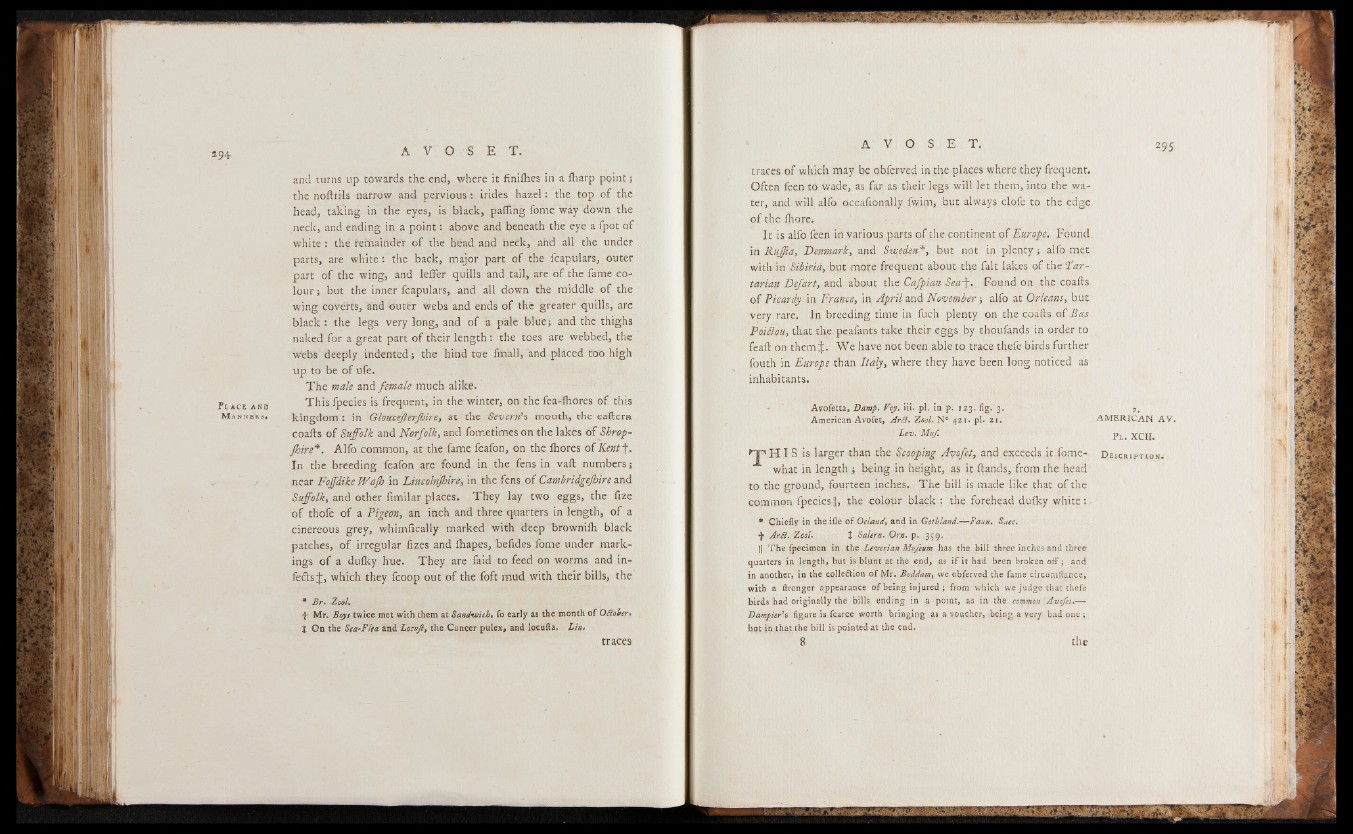
P la c e and
M anners *
and turns up towards the end, where it finilhes in a fharp point j
the noftrils narrow and pervious: irides hazel: the top of the
head, taking in the eyes, is black, palling fome way down the
neck, and ending in a point: above and beneath the eye a fpot of
white : the remainder of the head and neck, and all the under
parts, are white: the back, major part of the fcapulars, outer
part of the wing, and Idler quills and tail, are of the fame colour;
but the inner fcapulars, and all down the middle of the
wing coverts, and outer webs and ends of the greater quills, are
black: the legs very long, and of a pale blue; and the thighs
naked for a great part of their length: the toes are webbed, the
webs deeply indented; the hind toe fmall, and placed too high
up to be of ufe.
The male and female much alike.
This fpecies is frequent, in the winter, on the fea-lhores of this
kingdom : in Gloitceftirjhire, at the Severn’s mouth, the eaftern
coafts of Suffolk and Norfolk, and fometimeS on the lakes of Shrop-
Jhire*. Alfo common, at the fame feafon, on the Ihores of Kent f .
In the breeding feafon are found in the fens in vail numbers;
near Foffdike Wajh in Lincolnjhire, in the fens of Cambridgejhire and
Suffolk, and other fimilar places. They lay two eggs, the fize
of thofe of a Pigeon, an inch and three quarters in length, of a
cinereous grey, whimfically marked with deep brownilh black
patches, of irregular fizes and lhapes, befides fome under markings
of a dulky hue. They are faid to feed on worms and in-
fefts J, which they fcoop out of the foft mud with their bills, the
* Br» Zool.
*|- Mr. Boys twice met with them at Sandwich» fo early as the month of Oiïober.
j On the Sea-Flea and Locuft, the Cancer pulex, and locufta. Lino
traces of which may be obferved in the places where they frequent.
Often feen to wade, as far as their legs will let them, into the water,
and will alfo occafronally fwim, but always clofe to the edge
of the Ihore.
It is alfo feen in various parts of the continent of Europe. Found
in Ruffia, Denmark, and Sweden*, but not in plenty; alfo met
with in Sibiria, but more frequent about the fait lakes of the Tartarian
Defart, and about the Cafpian .Sea j v Found on the coafts
of Picardy in France, in April and November; alfo at Orleans, but
very rare. In breeding time in fuch plenty on the coafts of Bas
PoiUou, that the peafants take their eggs by thoufands in order to
feaft on them J. We have not been able to trace thefe birds further
fouth in Europe than Italy, where they have been long noticed as
inhabitants.
Avofetta, Damp. Voy. iii. pi. in p. 123. fig. 3. 2.
American Avofet, Artt, Zool. N° 421. pi. 21. AMERICAN AV.
Lev. Muf. pL. XCXI. T HI S is larger than tlie Scooping ffi'uo.j'&ty and exceeds 1,c lornc- Description*
what in length; being in height, as it ftands, from the head
to the ground, fourteen inches. The bill is made like that of the
common fpeciesH, the colour black: the forehead dufky whiter-
• Chiefly in the ifle of 0 eland3 and in Gothland.-—Faun % Suec.
•J* Arffi. Zool. J Salem. Orn. p. 359.
I| The fpecimen in the Leverian Mu/eum has the bill three inches and three
quarters in length, but is blunt at the end, as if it had been broken off; and
in another, in the collection of Mr» Boddam, we obferved the fame circumftance,
with a ftronger appearance of being injured j from which we judge that thefe
birds had originally the bills ending in a point, as in the common Avofet.—
Dampier’ s figure is fcarce worth bringing as a voucher, being a very bad one;
but in that the bill is pointed at the end.
8